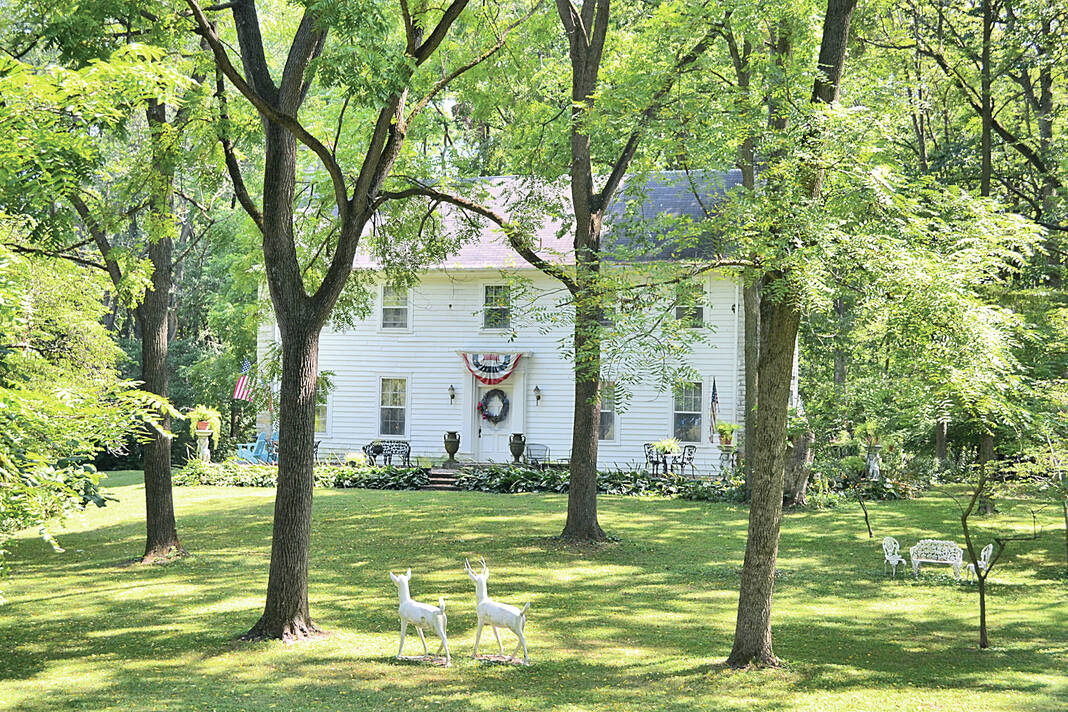
Stephen Jackson

Innis House.
By Stephen Jackson | For The Times-Post
Alexandria holds the unique distinction of being selected in 1943 from a list of towns all across America as the subject of a U.S. Government Office of War Information booklet titled, Small Town, U.S.A.
The purpose of the project was to correct the many false impressions people in foreign countries had of American life which they had acquired from watching American made motion pictures.
Small Town U.S.A. was to be the one publication that could help convince the people of the world of the overwhelming power and incontestable good faith of the United States by informing them of the nature of our country, our people and our way of life.
In May 1943, the New York office sent writer Betsy Emmons and photographer David Eisendrath to Alexandria to collect photographs and interviews.
They arrived on May 21.
They completed making the pictures and gathering the statistical data which was used in the book on June 14, 1943.
Local press releases mention that arrangements for the visit had been coordinated with the city authorities and the Civilian Defense Council.
Emmons and Eisendrath stayed at the Dahl & Eva Strickler home, the town’s funeral director, during their two-week stay in Alexandria.
Their base of operations was the Old English Hotel on Harrison Street, later the Broyles Furniture Store.
Interviews were conducted in their hotel rooms.
Eisendrath took pictures everywhere around town,
The Times-Tribune reported on May 24: “Scores of pictures were made on the street Saturday and Saturday night.”
Records reveal that the photographer took more than two hundred photographs of Alexandrians engaged in every facet of daily life.
Alexandrians were depicted working, playing, studying and worshiping.
Eisendrath portrayed the majority of his subjects in natural everyday situations.
Ernie and Carolyn Phillips were photographed working in their Victory Garden.
Location: 310 E. Madison Street.
Some of the photos were staged.
The Blake children remembered distinctly that the picnic basket in their family scene was empty.
Pictured L-R: Joe Blake (father), Joyce Ann (Mrs. John Grose) Blake, Rosemary (Mrs. Rev. James Williams) Blake, Janelyn (Mrs. Phillip Levi) Blake, Ruth Blake (mother) Wayne Blake, Phillip Blake.
The emotional shot of a grieving family leaving the burial site (Forrestville Cemetery in Boone Township) of a wounded soldier implied that the soldier was recently killed in action.
Actually the soldier, Private Louis Oliver Reason, had been a veteran of World War One.
He had been wounded overseas and sent back home, where he died May 31, 1943, at a government hospital in New York.
Pictured are: Mrs. Ralph Rayment, Rev. Ralph Rayment, ( Minister at Orestes Baptist Church), Grace Laycock, (sister of Private Reason), Emory Laycock.
The poignant good-bye kiss at the railroad station was real, however, as the Elwood resident leaving for service, Pernod Van Ness, was verified.
Pictured Front Row L-R: Walter Van Ness, Ruby ( Mrs. Penrod Van Ness), Penrod Van Ness, LaVisa (Mrs. Walter) Van Ness.
In accordance with common OWI procedure, Emmons and Eisendrath told local people as little as possible.
Virtually everyone knew that this job was a classified activity.
When Sara Culbertson Fox was asked to pose for a photo in a crowded bowling alley (Ault’s Recreation 213 N. Harrison St.), she saw no photographers and had a sense that “everything was hush hush. No questions asked.”
It did not occur to those participating in the project to question the government’s motives.
The arrival of the Lafayette, Muncie & Bloomington Railroad and discovery of natural gas served as a stimulus for yet another Monroe Township community 1 1/2 miles west of Alexandria.
Orestes was established soon after the Lafayette, Muncie & Bloomington Railroad was completed in 1876.
After the discovery of natural gas, a large glass factory and a tile works were located there and the population increased.
It was about this time the town was incorporated, the order of the commissioners to that effect being made late in the year 1894.
But, it wasn’t always called Orestes.
Called Lowry’s (Switch) Station it was originally a switching station near a grain elevator.
The station was named after Nathan Lowery who insisted on a town being established on the spot.
Later, and at the insistence of Nathan Lowery, it was named Orestes after a Greek mythical character whose escapades drove him to madness.
Orestes is home to a magnificently beautiful White Oak tree that was named “Tree of the Year” by the Indiana chapter of the International Arboriculture Society in 1980.
Ten years earlier, arborists from Purdue University approximated its age to date from 1670 and measured 77 inches in diameter.
The Madison County Historical Society secured and dedicated a bronze plaque to the great oak May 6, 1973.
It is displayed on a boulder beside the enduring hardwood which survived the tornado of 1922 and numerous lightning, wind and ice storms.
Osceola, located one mile directly north of Orestes, was laid out in 1855.
Legend says it derived its name from the celebrated Seminole Indian Chief.
At one time it promised to become a place of some importance.
E.M. Trowbridge opened a general store there soon after the town was laid out.
David Perry established the first blacksmith shop and Absalom Webb was the first shoemaker.
A large steam saw mill was built but after the most valuable timber had been manufactured into lumber the mill was taken away.
The loss of the mill, the building of railroads through other parts of the county, and the discontinuance of the post office, all contributed to the decline in the growth and prosperity of Osceola.
Like so many communities in Madison County, the Osceola Post Office, established in September 1858, was forced to change its name probably due to a conflict with another one by that same name.
In June of 1859, it became the Mercury post office which operated for 20 years.
The name was so widely accepted as the second name for the community at the crossroads of CR 300W and CR 1300N that it began to appear on maps as early as 1864 and continued until 1879.
The name Osceola first re-appears on county maps in 1886.
Gilman was a thriving place for about 75 years, starting in the late 1870s.
That’s when Jacob Miller decided to plat a village because the Lafayette, Muncie & Bloomington Railroad ran along that piece of land.
Located six miles southeast of Alexandria it was regarded as a “flag stop” by the railroad and so the trains had to be signaled to stop.
In the beginning, the town was called Business Station, obviously because of all the business the railroad and the free flow of natural gas brought there.
It once had three taverns, glass and brick factories, a school, church and doctor.
It is located on the north side of CR 900N and the west edge of CR 500E.
But with Business Stations popping out like mushrooms all over the Indiana landscape the name Gilman might just have been handed to the folks on a platter by the postal authorities.
In between Business Station and Gilman names, the community was called Purdue, a post office by that name existed there for less than two years, August 25, 1876 to June 10, 1878, before it was changed for the third and last time to Gilman.
The name Gilman first appears on an 1883 county map.
Slickum/Slickville was the name of what must have been a very small farming community that was near where CR 1250N intersects with CR 500E about five miles east of Alexandria.
General Store operated by Herschel Hamilton.
Slickville Tile Works – 1883-1910.
Alexandria has had two place-names within its limits that were created solely for special taxing considerations.
When Aladdin Industries Inc., came in from Chicago to establish a factory in Alexandria, it set up an incorporated town of its own on West Washington Street.
While the factory was active, the town of Aladdin was administered as a separate entity.
When Aladdin ceased operations and the industrial property was sold, the town’s area once again became a part of Alexandria.
The second such arrangement was called Gimco City.
It was a southwest section of the city established for the Alexandria General Insulating and Manufacturing Co. Incorporated (GIMCO) in 1929.
It was abolished 1977.
The final stop in Monroe Township is a neighborhood clustered around the intersection of CR 100W and Fourth Street on Alexandria’s southwest side called Innisdale.
It takes its name from a family named Innis who once lived there and whose home still stands on the east side of CR 100W a short distance north of 4th Street.
At one time, the population of Innisdale was enough to warrant two elementary schools, one for grades one through four and the other for grades five through eight.
Madison County Historian Stephen Jackson is leading a series of “First Sunday” presentations covering the History of Madison County townships. The talks are set for 2 p.m. on the first Sunday each month in the Bowman Room at Museum of Madison County History, 11 W. 11th St., Anderson. The talks began Sept. 4 and run through Nov. 5, 2023. The information he prepares for those presentations form the basis of this series of columns in The Times-Post.